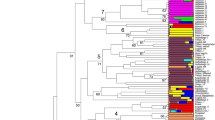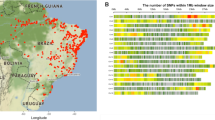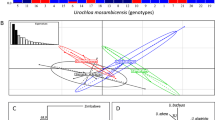Abstract
Despite its importance as a staple food throughout the tropics, the root crop cassava (it Manihot esculenta ssp. esculenta) has traditionally not been a major focus of research. One basic question about cassava that remained unresolved until recently concerns the crop’s origin. This paper describes analyses of SNPs (single nucleotide polymorphisms) and SSR (simple sequence repeat) variation as a means of tracing cassava’s evolutionary and geographical origins. Genetic diversity was examined in a sample of 20 cassava varieties that are representative of germplasm diversity within the crop, and in 212 individuals collected from wild populations of two closely related Manihot species. SNP and indel variation was examined in portions of two low copy nuclear genes, BglA and Hnl. Inferences from these genes were compared to those from previously examined loci, including the low copy nuclear gene G3pdh and 5 SSR loci. For all genes examined, SNPs and SSR alleles are shared between domesticated cassava and a specific geographical subset of wild Manihot populations, which suggests the following: (1) Cassava was likely domesticated from a single wild Manihot species, M. esculenta ssp. flabellifolia, rather than from multiple hybridizing species, as traditionally believed; and (2) the crop most likely originated in the southern Amazon basin.
Similar content being viewed by others
Author information
Authors and Affiliations
Corresponding author
Rights and permissions
About this article
Cite this article
Olsen, K.M. SNPs, SSRs and inferences on cassava’s origin. Plant Mol Biol 56, 517–526 (2004). https://doi.org/10.1007/s11103-004-5043-9
Received:
Accepted:
Issue Date:
DOI: https://doi.org/10.1007/s11103-004-5043-9




